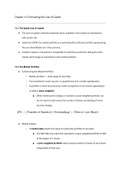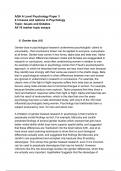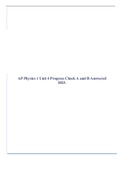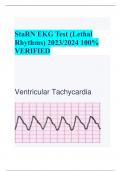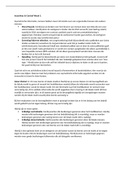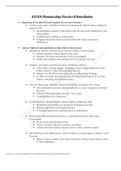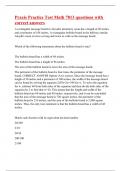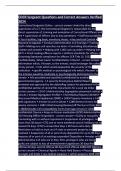Chapter 12: Estimating the Cost of Capital
12.1 The Equity Cost of Capital
● The cost of capital is the best-expected return available in the market on investments
with similar risk.
● Under the CAPM, the market portfolio is a well-diversified, efficient portfolio representing
the non-diversifiable risk in the economy.
● Investors require a risk premium comparable to what they would earn taking the same
market risk through an investment in the market portfolio.
12.2 The Market Portfolio
● Constructing the Market Portfolio
○ Market portfolio → total supply of securities
○ The investment in each security i is proportional to its market capitalization.
○ A portfolio in which each security is held in proportion to its market capitalization
is called a value-weighted.
■ When market prices change, to maintain a value-weighted portfolio, we
do not need to trade unless the number of shares outstanding of some
security changes.
● Market Indexes
○ A market index reports the value of a particular portfolio of securities.
■ The S&P 500 is an index that represents a value-weighted portfolio of 500
of the largest U.S. stocks.
■ A price-weighted portfolio holds an equal number of shares of each stock,
independent of their size.
, ● Investing in a Market Index
○ Many mutual fund companies offer funds, called index funds, that invest in these
portfolios.
○ An exchange-traded fund (ETF) is a security that trades directly on an exchange,
like a stock, but represents ownership in a portfolio of stocks.
■ By investing in an index or an exchange-traded fund, an individual investor
with only a small amount to invest can easily achieve the benefits of broad
diversification.
● The Market Risk Premium
○ The market risk premium is the expected excess return of the market portfolio.
● E[RMkt] - rf
○ This provides the benchmark by which we assess
investors’ willingness to hold market risk
● Determining the Risk-Free Rate
○ The risk-free interest rate in the CAPM model corresponds to the risk-free rate at
which investors can both borrow and save.
○ We use a short-term risk-free rate to evaluate a short-term investment, and a
long-term rate when evaluating a long-term investment.
● The Historical Risk Premium
○ It takes many years to produce even moderately accurate estimates of expected
returns.
○ The yield curve has tended to be upward slowing, with long-term interest rates
higher than short-term rates.
○ The market risk premium has declined over time
1. More investors participate in the stock market today → risk
shared
12.1 The Equity Cost of Capital
● The cost of capital is the best-expected return available in the market on investments
with similar risk.
● Under the CAPM, the market portfolio is a well-diversified, efficient portfolio representing
the non-diversifiable risk in the economy.
● Investors require a risk premium comparable to what they would earn taking the same
market risk through an investment in the market portfolio.
12.2 The Market Portfolio
● Constructing the Market Portfolio
○ Market portfolio → total supply of securities
○ The investment in each security i is proportional to its market capitalization.
○ A portfolio in which each security is held in proportion to its market capitalization
is called a value-weighted.
■ When market prices change, to maintain a value-weighted portfolio, we
do not need to trade unless the number of shares outstanding of some
security changes.
● Market Indexes
○ A market index reports the value of a particular portfolio of securities.
■ The S&P 500 is an index that represents a value-weighted portfolio of 500
of the largest U.S. stocks.
■ A price-weighted portfolio holds an equal number of shares of each stock,
independent of their size.
, ● Investing in a Market Index
○ Many mutual fund companies offer funds, called index funds, that invest in these
portfolios.
○ An exchange-traded fund (ETF) is a security that trades directly on an exchange,
like a stock, but represents ownership in a portfolio of stocks.
■ By investing in an index or an exchange-traded fund, an individual investor
with only a small amount to invest can easily achieve the benefits of broad
diversification.
● The Market Risk Premium
○ The market risk premium is the expected excess return of the market portfolio.
● E[RMkt] - rf
○ This provides the benchmark by which we assess
investors’ willingness to hold market risk
● Determining the Risk-Free Rate
○ The risk-free interest rate in the CAPM model corresponds to the risk-free rate at
which investors can both borrow and save.
○ We use a short-term risk-free rate to evaluate a short-term investment, and a
long-term rate when evaluating a long-term investment.
● The Historical Risk Premium
○ It takes many years to produce even moderately accurate estimates of expected
returns.
○ The yield curve has tended to be upward slowing, with long-term interest rates
higher than short-term rates.
○ The market risk premium has declined over time
1. More investors participate in the stock market today → risk
shared



